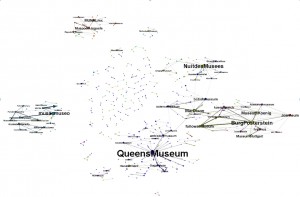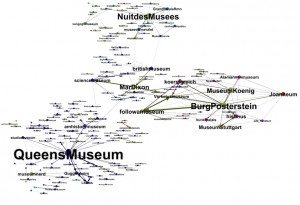Do Museums Worldwide form a true Community on Twitter? [Some insights on the museum Twitter ecosystem through Social Network Analysis and Network Science]
Best Practice SessionAlex Espinós, Spain
We have monitored all public interactions among 3.500 museums on Twitter for 8 months. This is still an ongoing analysis.
We have 3 sets of interactions: followers, mentions and retweets; 3 graphs that we can compare and overlay.
Goals
The main goals are to try to answer the following questions:
- Do the worldwide museums form a community on Twitter? Or several different communities?
- In the latter case: which is the main criterion that explains the observed community structure: topic (i.e. contemporary art museums on one community, archaeological ones on another), language or country? Do the Twitter communities seem to mimic patterns of offline relationships?
- The answers to these questions have consequences on how Museums actually use Twitter, and if it is used to share experiences and knowledge.
- Which are the communities? Which are the key players in each community?
- Does the small world principle apply? And the strength of weak ties? To what extend?
- Are there structural holes, that is, museums that relate otherwise unrelated groups? Which are these key players in group connection and information spread?
- Which are the most influential museums, not in terms of followers, but in terms of influence within the group of museums?
Methodology
We have gathered the data through Twitter API, and analyzed it with the tools of Social Network Analysis and Network Science[1]. For visualizations we use Gephi[2] (open source) and we will provide the raw graphs[3] for anyone wanting to analyze them.
For the list of museum’s Twitter profiles, we have used Museum Analytics[4] lists.
Part of the 3.500 museums has had no activity relating them to other museums. For the rest we make a selection consisting in erasing the relations between museums with 2 or 1 links in the 4 month period. That leads to the core of the graph, the set of the most active museums: 408 museums, 892 links.
Preliminary findings
This is the core graph:
There is one main component (right), and two important components (left and top-left). Apart from that, we have many components of less than 10 museums each.
If we take a closer look to the main component (see image below), we can see that it is made up of three different museum communities: US (left), French (top) and German (right).
These communities are glued together by some key UK players: Mar Dixon and Poole Museums bind the German community to the main component. Without these two profiles, the German component would be an isolated community. These are clear examples of structural holes in the graph, and how two key players assure the spread of knowledge and news. This finding have consequences about the way Twitter is used by European museums, and what can be done to improve the spread of ideas and experiences.
The British Museum and the Science Museum play a similar role.
The German community is connected to the main component, but the Spanish and the Latin American ones are not. They are isolated from the main component, and from each other. These are the second and third components in size:
Spanish Museums
Latin American Museums
There is not an Italian component, Italian museums have not a strong presence in the graph and they appear scattered among different small components.
Country and language seem to dominate over topic in the formation of Twitter communities.
[1] en.wikipedia.org/wiki/Social_network_analysis i en.wikipedia.org/wiki/Network_science




